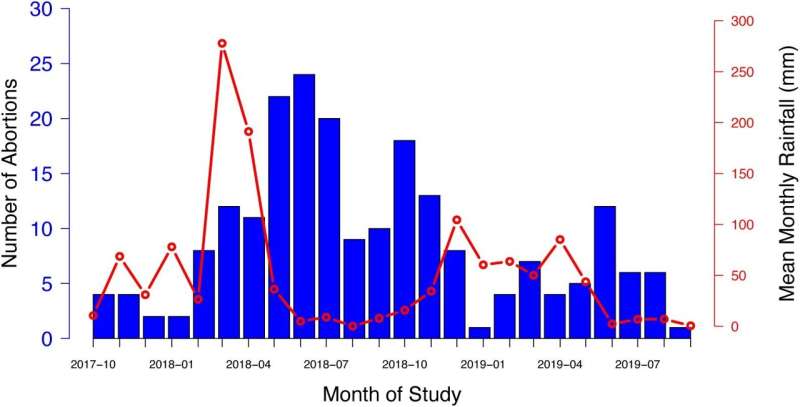This article has been reviewed according to Science X's editorial process and policies. Editors have highlighted the following attributes while ensuring the content's credibility:
fact-checked
peer-reviewed publication
trusted source
proofread
Livestock abortion surveillance could protect livelihoods and detect emerging global pathogens

A small-scale surveillance system in Tanzania for reporting livestock abortions could help protect livelihoods and provide insights on potential livestock-to-human infections.
The research, led by Washington State University in collaboration with the University of Glasgow and published as a reviewed preprint in eLife, is described as an important study with convincing findings of potential interest to the fields of veterinary medicine, public health and epidemiology.
Loss of livestock through abortion is a major concern for the worldwide livestock industry, resulting in significant economic loss and posing a direct threat to public health through transmission of infection. The impact of livestock abortion on the world's poorest livestock keepers is likely to be substantial—from the direct loss of high-quality food sources and reduced income from sales of milk or meat. However, currently there is limited information on livestock abortion, particularly in low and middle-income countries.
To address this gap, researchers set up a pilot livestock surveillance system in northern Tanzania in 15 wards across five districts, with a mix of pastoral, agropastoral and smallholder livestock keepers. Livestock field officers (LFOs; government employees equivalent to para-veterinarians) received training on the safe investigation of livestock abortion and were requested to report any incidents of abortions, stillbirths and perinatal death.
If the cases could be followed up within 72 hours of the abortion event, further investigation including blood, milk and vaginal swabs were collected from the aborting dam, alongside tissue and swab samples from the fetus and placenta. These were tested for a wide range of infectious agents and antibodies.
Between 2017 and 2019, 215 abortion cases were reported from 150 households in 13 of the 15 wards. Of these 215 cases, 70% were reported by three (20%) of the LFOs. Most abortions were investigated within two days, and none were investigated more than four days later. Placental and fetal tissues were only collected in 24% and 34% of cases, respectively, often because these tissues were not found, but vaginal and milk samples were collected in 99% and 78% of cases.
Although data was only available for a limited number of abortions, the results revealed important insights into likely patterns and causes. For example, abortions occurred more often in the dry season, and in non-indigenous cross-bred or exotic animals than in indigenous breeds.
More than a fifth of dams that aborted were reported to have experienced a previous abortion, with several experiencing multiple abortion losses, which may suggest that animals suffering recurrent abortion events may have a chronic infection that would warrant their removal from breeding stock or prevent their use as a food source.
Senior author of the study, Professor Sarah Cleaveland, professor of comparative epidemiology at the School of Biodiversity, One Health & Veterinary Medicine, University of Glasgow, said, "Our study has demonstrated that livestock abortion surveillance, even at a relatively small scale, can capture valuable information about livestock pathogens, including those that are zoonotic.
"Moreover, our pilot demonstrates the utility and feasibility of livestock abortion surveillance in rural areas and highlights that engaging field officers, establishing practical and robust field sample collections and ensuring prompt reporting of cases and feedback of results are key elements of effectiveness."
The study emphasizes the potential risks of exposure to zoonotic pathogens—infectious agents that could potentially jump from livestock to humans. In cases where an infectious agent was detected, 79% were zoonotic, and in nearly a quarter of these cases, someone had assisted with the aborted delivery, likely without any personal protective equipment. Of these, 20% were female and of reproductive age, and therefore of heightened risk from certain pathogens.
Lead author of the study, Felix Lankester, Clinical Associate Professor at the Paul G. Allen School for Global Health, Washington State University, Washington, US, and the Global Animal Health Tanzania, Arusha, Tanzania, said, "Effective livestock health surveillance provides critical data for evidence-based approaches to disease control and management, but requires reliable, high-quality and timely data drawn from multiple sources.
"Event-based surveillance can detect early events that signal emerging human health risks, and surveillance of livestock abortion events has clear potential for identifying and preventing outbreaks of emerging diseases. However, there is limited information on the current practices, effectiveness and challenges of livestock abortion surveillance, particularly in low and middle-income countries."
More information: F. Lankester et al, The value of livestock abortion surveillance in Tanzania: identifying disease priorities and informing interventions, eLife (2024). DOI: 10.7554/eLife.95296.1
Journal information: eLife
Provided by University of Glasgow





















